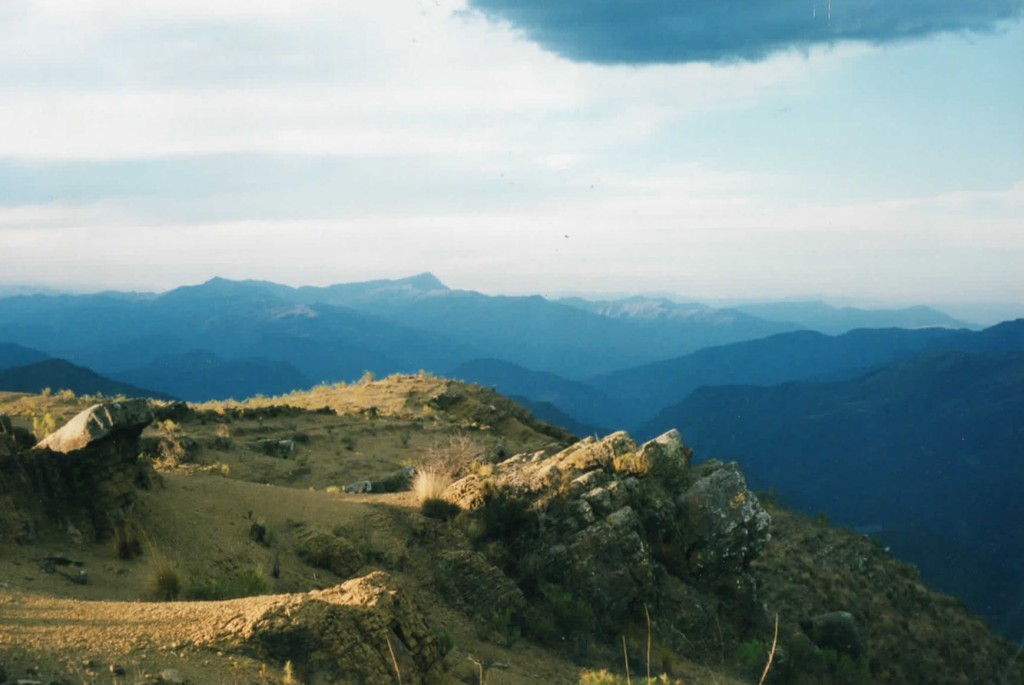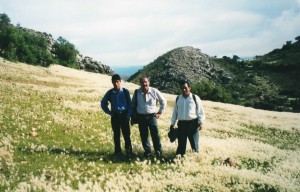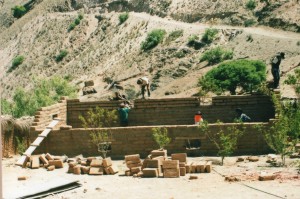
*Warning: This post starts with a story, ends with a rant, and has little to do with science. Read at your own risk.
In 2001, I joined the Peace Corps and moved to a tiny village in the middle of Bolivia called Chuqui Chuqui. My job description was vague. I taught some English. I gave talks on nutrition and hygiene. I showed the kids how to make recycled paper. Mostly, I just kind of coasted, not really knowing what to do. My Bolivian “counterpart” — a guy named Walter who was supposed to keep me occupied — didn’t live in my village and only visited every other week. His job was to help the teachers develop their curricula, and he had many schools to oversee.

One day, Walter asked me if I wanted to accompany him on a trip to visit some nearby schools. The schools he planned to call on were up in the mountains. The rains had washed much of the road away, and we didn’t have a car. So this would be a three-day walking tour. To avoid the heat, we set off at an ungodly hour — five or six in the morning. Walter picked his way through the rocky ravine like a goat with the instincts of homing pigeon. Five long hours and many switchbacks later, we arrived at Qullpana — our first stop. And that afternoon, we made our way to Kikijana.

These towns, with their smattering of ramshackle adobe sheds and lack of electricity, made Chuqui Chuqui, my small village, look modern and well equipped. I immediately fell in love with the region and decided I wanted to work there. Because of the altitude and the cold, not many vegetables grow in Qullpana and Kikijana. So after several meetings, the residents and I decided to build two school greenhouses — one in each town. It took many months. Even though my dad had volunteered to donate the money — $400 — I had to draft a project proposal. Members of the community had to make adobe bricks. And we had to haul the other supplies up on donkeys. I wouldn’t call the greenhouses an unmitigated success, because I have no idea if they’re still in operation. I tell you these things because they are the facts. And this blog is nonfiction. So I would never say that I had built 11 greenhouses. Nor would I tell you that I was once held at gunpoint on the road between Kikijana and Qullpana. If I did, I would be lying.
See? It’s easy to sort out fact from fiction. I don’t understand why Greg Mortenson is having such a hard time.
Greg Mortenson is the founder of Central Asia Institute (CAI), a non-profit dedicated to building schools in remote regions of the middle east. He detailed his heartwarming experiences in Pakistan and Afghanistan in a book called Three Cups of Tea that he co-authored with David Oliver Relin. Last week, 60 Minutes and Jon Krakauer accused Mortenson of fabricating many of the details in Three Cups of Tea and the sequel, Stones into Schools.
This news came as a shock. I had read Three Cups of Tea and loved it. I respected Mortenson. Some people who do development work don’t spend much time in the places they’re charged with developing. Instead they sit in air-conditioned offices in capital cities behind locked iron gates manned by security guards. I thought Mortenson was cut from a different sort of cloth — the same sort of cloth that made me load my backpack with nails and trek 20 kilometers up the side of a mountain to deliver them. So when I saw the headlines, I thought there must have been some mistake.
But the evidence in Jon Krakauer’s scathing 89-page takedown of Mortenson, Three Cups of Deceit, is damning. As I read, I grew increasingly infuriated. Mortenson didn’t just embellish details or confuse dates. If what Krakauer wrote is true — and I have every reason to believe that it is — Mortenson outright lied. What’s worse, he used donations made to Central Asia Institute to hire private jets to take him to speaking engagements, where he promoted his books. And oh-by-the-way, none of the proceeds of his books actually go to Central Asia Institute.
In an interview without Outside magazine, Mortenson acknowledged that there were “compressions and omissions” in Three Cups of Tea, but he didn’t own up to lying. And he shoved most of the blame onto Relin, who he claims took too much literary license. “So rather than me going two or three times to one place, [Relin] would synthesize it into one trip. I would squawk about it and be told that it would all work out,” he said.
The person I most want to hear from — Relin — has been surprisingly silent. In a 2008 interview with Michael Werner, Relin claims that he wrote the book and was dismayed that Mortenson appeared as co-author. When Werner asks him what type of research he did, Relin replies, “I interviewed Greg at length, of course. We also pored over old photos and videotapes of his trips to Pakistan and Afghanistan. Beyond that, I conducted over 200 interviews with people who had worked with Greg, CAI staff and supporters in the U.S. and Pakistan, the children and village leaders whose lives had been changed by Greg’s work, and anyone else I could think of who could bring another facet of this story into focus.”
Mortenson may have lied. But I find it hard to believe that Relin wouldn’t have uncovered the truth in the process of conducting 200 interviews. After all, Krakauer only had to talk to Mortenson’s climbing buddy and their porters to unearth one apparent fabrication: Mortenson claims to have stumbled into the village of Korphe, where he later built a school, after getting lost on his way back from a failed attempt at K2. His buddy and the porters say he hiked out with them.
Krakauer saves this humdinger for an end note. Three Cups of Tea claims Mortenson learned of Mother Teresa’s death while he was on a layover in Calcutta in September 2000. He goes to visit her corpse. According to the book, “She lay on a simple cot, at the center of a bright room full of flickering devotional candles . . . ‘I sat in the corner staring at this shrouded figure,’ Mortenson says. ‘She looked so small, draped in her cloth.’ . . . Mortenson knelt on the cool tiled floor next to Mother Teresa and placed his large palm over her small hand.”
“This is a poignant anecdote, but it’s difficult to reconcile with the fact that Mother Teresa died on September 5, 1997,” Krakauer writes. Whether Mortenson fabricated the whole event, or whether someone just got the date wrong is unclear. And what role Relin played in this mistake and the many others in Three Cups of Tea is not yet known. But it seems safe to say that he could have used a good fact checker.
On his blog, journalist Dan Glick defends Mortenson. He writes, “Mortenson has gone where few others have gone, and has put in incredible time and energy to raise awareness, seed schools, and give girls opportunities for education that would not be theirs otherwise. I have no doubt he has done orders of magnitude more good than harm.” I also don’t doubt Mortenson has done a lot of good. But that doesn’t give him a free pass. Fraud is fraud is fraud.
Unbelievably, some people are angry at Krakauer. One of the commenters on Glick’s post writes, “There are two sides to every story, sadly people just cling to one story and ignore the real truth. I wish Krakauer instead of accusing Mortenson should go and do the same projects in Afghanistan and let us see how far he goes on that.” I say kudos to Krakauer for using his skills as a journalist to bring Mortenson’s fabrications and mismanagement of Central Asia Institute to light. Perhaps his article was a tad vicious. But over the years, Krakauer has donated $75,000 to CAI. He has every right to be angry.
**
Image credits: Cassandra Willyard
More on the Mortenson scandal:
Three Cups of Deceit (Byliner.com)
Questions over Greg Mortenson’s Stories (60 Minutes)
60 minutes expose on Mortenson is weak — and wrong (Daniel Glick)
Portland writer David Oliver Relin said he wrote ‘Three Cups of Tea’ (OregonLive.com)
Geek Ethics: Is it Important that Greg Mortenson Lied? (Wired)
Condemning Greg Mortenson and a Thousand Little Girls (HuffPo)
‘Three Cups of Tea,’ Spilled (New York Times – Nick Kristof)
Mortenson Scandal Draws Montana AG’s Attention (Wall Street Journal)
What Mortenson Got Wrong (The New Yorker, a must-read)
May I please borrow that expression “Bull Honkey” ? I have never heard of it but it’s perfect. At least I know for a fact that I make up absolutely everything when I draw.
I don’t understand the Mother Theresa thing…are they saying that too much time had passed since her death for there to be a visit-able corpse? if I go to visit someone’s grave, aren’t I visiting their corpse?
This wasn’t just visiting the grave. He actually went and sat beside her body. This is from Three Cups of Tea: “Mortenson knelt on the cool tiled floor next to Mother Teresa and placed his large palm over her small hand.” I’ll clarify that in the text.
And Rosie, feel free to go forth and use ‘bull honkey’ whenever you please. It’s a good expression, and one for which I can’t take credit.
wow, unbelievable! (and kind of amazing that it took so long for all of these huge errors to be noticed, ya?)
Well, as long as the schools he built are real, the rest is superfluous. Yes, lying is bad but “Three Cups of Tea” is a fun read (I borrowed instead of bought). The schools are the only thing that matter and it’s not like other charities (or the Pakistan government) are quick to go there to build schools.
Good post. Being charitable does not give anyone a free pass on telling the truth.